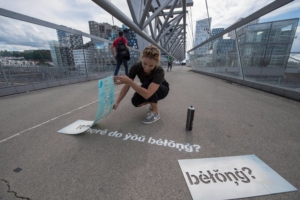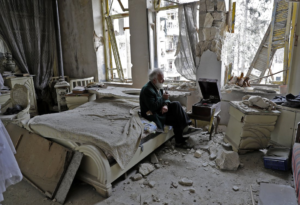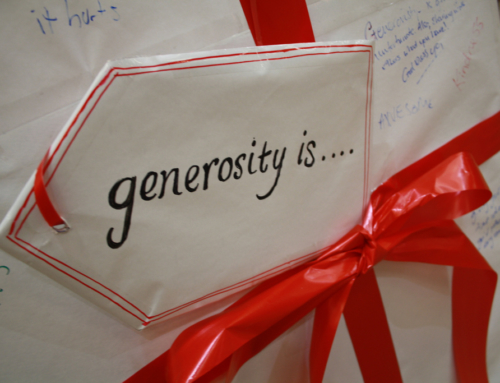By Eddie Pipkin
July 21, 2017
On my visit to Oslo, Norway, I was walking across a pedestrian bridge into one of the city’s bright new architecturally exciting neighborhoods, when I noticed a phrase painted on the sidewalk (in Norwegian, but I could parse the meaning). The words on the sidewalk said: “Could you belong here?” I had just been thinking that myself. Could I see myself living in this city so different from the place I have chosen to live? Could I make a home here? It struck a powerful cord that the someone in the city itself seemed interested in my answer to that question. They seemed genuinely interested in what I had to think and whether I could see myself as part of that community.
It turns out that this question and other versions of it (“Where do you belong?” “Can you see yourself here?”) were part of an exhibition and project by the Norwegian Museum of Architecture and Design exploring how public architecture and neighborhood planning influence people’s sense of connection. The project probed what it takes for people to feel like they have created a home.
As ministry leaders, it is a question that we should be asking those who take the time to engage with us (through visits, through inquiries, in speculative conversation). It’s an aspirational question. It’s an empathetic question. It flips the script. As people are exploring our ministry settings, too often we are in full recruitment mode, so that the focus becomes selling them on who we are, while giving short shrift to the idea of who they are and how they will fit with us. We ask these kinds of questions:
who take the time to engage with us (through visits, through inquiries, in speculative conversation). It’s an aspirational question. It’s an empathetic question. It flips the script. As people are exploring our ministry settings, too often we are in full recruitment mode, so that the focus becomes selling them on who we are, while giving short shrift to the idea of who they are and how they will fit with us. We ask these kinds of questions:
- Wouldn’t you like to be a part of all the amazing, cool things we are doing?
- You don’t want to miss out on the opportunity to be a part of our one-of-a kind ministry, now do you? Don’t you want to hear more about the many, many benefits that participation can offer?
- Wouldn’t it be a privilege for you to be accepted to be a part of the exclusive awesomeness of being part of our team? Don’t you want to sign up to jump all-in with your time and money right now?
- Have you read our brochure about the 142 programs we offer? How about the one celebrating the illustrious history of our church? Have you memorized the historical chart of our 17 former pastors yet?
What if we spent more time engaging people with these kinds of questions:
- Could you tell us more about the kind of community you are looking for?
- What is your story—what makes you unique—and how do you see the next chapter in your story unfolding?
- What brings you joy, and how could we help you engage that joy as part of our community? How would you like to be challenged, and how can our community be a part of helping you grow?
- What fears do you have as you engage with a new community? How can we help alleviate those fears?
- At what pace would you like to get to know this faith neighborhood?
This question of “Could you belong here?” indicates that it matters to us if people feel connected. Our ministries should not function as only one more civic-minded or self-help club that people can belong to. And we should not be like the gym membership that people undertake, get passionate about for a while and then fall away from. We should be about the deep connections that come when a community is fully engaged with the God who has called them to actively love another. They live out that love in the work of healing and social justice that grows out of a full understanding of how blessed and empowered they are. Each person has meaning and impact in such a community, and the strength of that community lies in fully valuing and engaging those individuals. Working together, they build an extended family, they produce vibrant, creative visions of life together, and they do work that changes the world.
People are hungry for this kind of connection. For any kind of connection. They will hover over social media to follow the latest trend and hop on the nearest fad in order to feel like life has meaning. I have, for instance, been intrigued by the growing American passion for avocado toast (and the inevitable backlash against the trendy upswing of avocado toast). If people are spending a million dollars a month to be a part of the avocado toast aficionado community, imagine if we redirected some of that enthusiasm and money to a more meaningful cause and connection.
I was also greatly moved back in March by the story of a Syrian man who was trying desperately to hold onto his community connection despite the disruption of war. He is Mohammed Mohiedin Anis (also known as Abu Omar), who had been featured in news articles as a collector of vintage automobiles, and who was now seeing his life crumble as the city he called home, Aleppo, was devastated around him. Reporter Sammy Ketz and a photographer tracked him down and recorded a haunting image as he sat among the ruins of his home,  most of his beloved cars destroyed or stolen, his family scattered to the refugee winds, and nothing left but his pipe and a record player to listen to music he loved:
most of his beloved cars destroyed or stolen, his family scattered to the refugee winds, and nothing left but his pipe and a record player to listen to music he loved:
And so they waited while Abu Omar lit his pipe, turned the crank and sat to enjoy the music on his broken bed, in his ruined room, in his destroyed home, in his obliterated city, in his fractured country. “He played one of his favorite songs,” Eid adds, an old Arabic tune by Syrian singer Mohamed Dia al-Din. “He is so attached to his past and to the things that he always cherished and loved, and without them he will lose his identity,” Eid says. “That’s why he insists on staying and getting back his life again.” It’s a scene he says he will never forget. “Whenever I feel or will feel any kind of despair or surrender to [life’s] problems and obstacles,” Eid says, “I will always [recall] the image of Abu Omar smoking his pipe while sitting on his rubble covered broken bed and listening to his favorite music.”
Everything was crumbling around him, and still he stayed.
Why? Because when we build deep connections, we long for them in ways that persist.
Those are the kinds of connections that ministry can and should build. Those are biblical connections, the kind that bonded Jesus and his original followers. The kind that bound the pioneers of the early church. The kind that build strong and vibrant ministries in which families of faith are created and endure. And all of this can start with a more attentive, engaging welcome that asks the question: “Could you belong here?”
What are your experiences in building community? What questions do you ask new pilgrims who come your way? How do you engage them in conversation that lets them know they are valued and that listens to the details of their story and meshes that story with the story of your unique ministry? What are the ways in which we thwart that process? Share with us, and check out the resources in our Connect! materials, which are all about building stronger communities. It’s just one of the many resources available at the EMC3coaching web site.







Leave A Comment